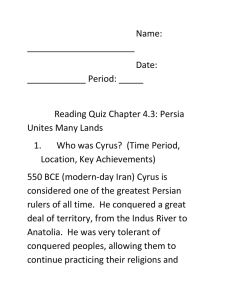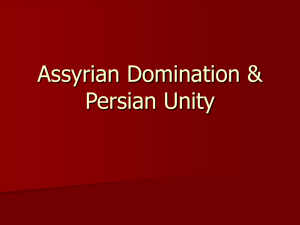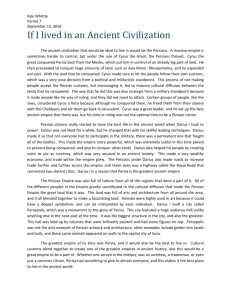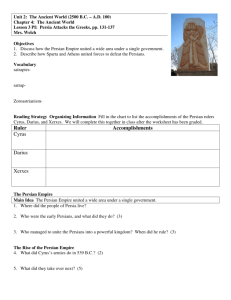550 bc
advertisement
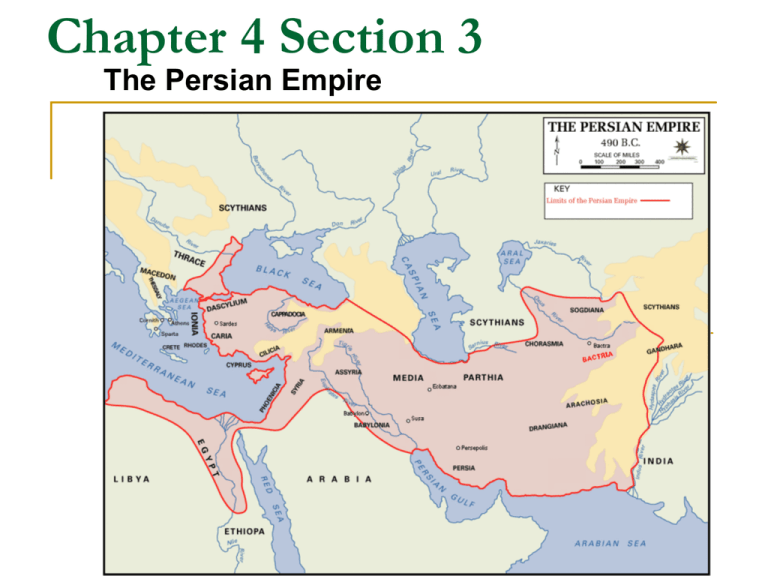
Chapter 4 Section 3 The Persian Empire The Rise of Persia Assyrians used force to control Persians used tolerance and diplomacy Iran The Persian Homeland Dozens of kingdoms Two major powers emerged: Medes and Persians King Cyrus lead the Persians to overthrow the Medes (550 b.c.) Cyrus the Great Founds an Empire Military genius Honored local customs and religions Allowed Jews to return to Jerusalem Jews rebuilt their city and temple Persian Rule 530 B.C. Cyrus dies Cyrus the Great (559-529 BC) "I am Cyrus, who founded the empire of the Persians. Grudge me not therefore, this little earth that covers my body." Tomb of Cyrus II of Persia at Pasargadae, Iran. Cambyses and Darius Cambyses takes over Egypt. Was he like Cyrus to the Egyptian people? Destroyed Egyptian culture and religious idols. Cambyses and Darius Continued 522 B.C, with the help of the Ten Thousand Immortals, Darius seizes control He brought peace to the empire then focused on extending the empire Immortals The 'Immortals', is the Greek term for the elite of the Persian army. They were hand picked for their bravery and so rewarded. Their name coming from the way their number never fell below ten thousand. The division was always kept up to full strength, retired or fallen soldiers were always replaced. In this way their strength was always 10,000 men, never more or never less. Entry to the ranks of the Immortals was restricted to those with Persian, Mede or Elamite ancestory. Provinces and Satraps (Ways rule was kept) Darius split expanding empire into 20 provinces Allowed people to keep their cultural traditions in place Provinces and Satraps Continued A satrap, governor, who kept local rule; a military leader and tax collector were appointed to each province System of roads were put in place; allowed for quicker communication Coins were used to promote trade The Royal Road Ran from Susa in Persia to Sardis in Anatolia 1,677 miles long Relay stations had fresh horses for kings messengers Took them 7 days to travel the entire road system Caravans took up to three months The body of the king of kings was balmed, placed in a coffin and transported to Naqs-I Rustam, (by Persepolis) where his tomb had been prepared a long time ago. Darius' eunuch, Bagapates, had guarded Darius' tomb for seven years before the great king died, which suggests that it was finished in 493. The Persian Legacy Zoroastrism Zoroastrianism was founded in the 6th century before Christ by the Persian prophet Zoroaster; at the time of Buddha. It was the official religion of the Persian Empire until it was conquered by Alexander the Great in 330 after Christ... if the battles at Marathon and Salamis would have been won by the Persians, today we would have probably in the Western civilization Zoroastrianism, instead of Christianity... finally the Muslims defeated them in the 7th century AC. The Zoroastrians were scattered, and today there are left 115,000 around Bombay, in India, and 7,000 in the United States. Zoroastrianism was thus the first to teach clearly the doctrines of an individual judgment, Heaven and Hell, the future resurrection of the body, the general Last Judgment, and life everlasting for the reunited soul and body. These doctrines were to become familiar articles of faith to much of mankind, through borrowings by Judaism, Christianity and Islam. Zoroaster’s Teachings Earth is a battleground where everyone must partake in the fight with good and evil. Ahura Mazda is the one god Judges how one fights for the battle of good 600’s religion declined Political Order Persian tolerance and good government brought political rest to Southwest Asia.
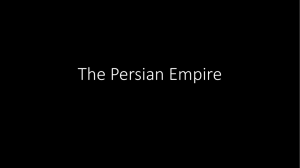
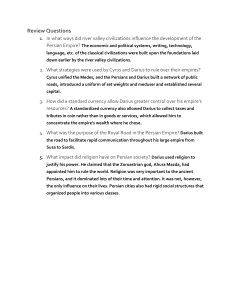
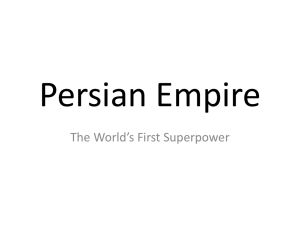

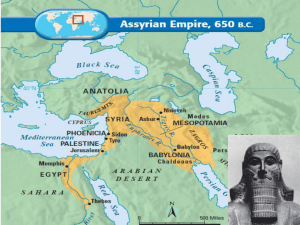

![This [empire] he set up in Persia; and afterwards he... governments of the kind which the Persians call satrapies, assigning... Histories Persia, 5](http://s2.studylib.net/store/data/015577482_1-6df1abb7e9538fea395f91c091a7ccda-300x300.png)
